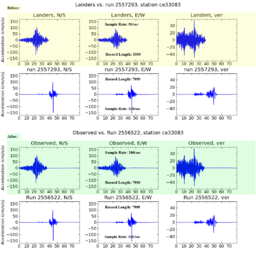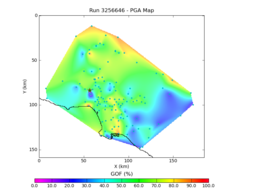Goodness of Fit
SCEC computational scientists often need to compare simulation parameters against observed geophysical and seismic observations. We often need to define what parameters we compare and how to evaluate groups of comparisons. Examples of Goodness of Fit in SCEC research includes Broadband Platform development, in the SCEC CVM development, in CISN EEW evaluation, and CSEP short term earthquake forecast testing.
Contents
Mayhew and Olsen
Mayhew and Olsen have developed and published the following paper on goodness of fit for ground motion modeling groups.
- Olsen, K.B., and J.E. Mayhew (2010). Goodness-of-fit Criteria for Broadband Synthetic Seismograms, With Application to the 2008 Mw5.4 Chino Hills, CA, Earthquake, Seism. Res. Lett., revised.
- Kim Olsen's Site for Paper Download
The algorithm computes:
- PGA, PGV, and PGD
- The response spectral acceleration averaged for periods between 0.1 and 10 s (RS)
- Fourier spectrum (smoothed to reduce variance; FS, Equation S6)
- Spectral acceleration at 16 individual periods used by recent NGA relations (SA16)
- Energy duration (DUR)
- Cumulative energy (ENER)
- Cross-correlation (Xcor)
- IE ratio is the ratio between the maximum inelastic and elastic displacements plotted against the strength reduction factor R
Broadband Platform
URS GoF
Broadband Platform v11.2 has integrated a bias calculation comparing forecast peak ground motion amplitudes against observed peak amplitudes. These bias plots are calculated for validation events for different code bases.
SDSU GoF
The SDSU - Mayhew & Olsen goodness of fit (MO-GoF) is being integrated into the next release of BBP. This GoF will be available as a selectable option in BBP workflow and the user can choose to run URS-GoF and/or MO-GoF.
Matching Seismograms
MO-GoF module requires the observed and synthetic seismograms to have the same sampling rate and record length before GoF metrics are calculated. Some metrics like cross correlation, energy duration and cumulative energy, require the observed and synthetic seismograms to be trace aligned manually to produce meaningful results. These three metrics will be disabled in the initial release of the module.
The BBP MO-GoF module includes code to match the observed and synthetic seismograms for each station in the station list before GoF is calculated. The trace matching code compares the observed and synthetic seismogram to determine if their sample rate or record length differ.
- Sample Rate: If the sample rate of one of the seismograms is lower than the other, the seismogram with the lower sample rate is up-sampled to match the sample rate of the other seismogram.
- Record Length: After the sample rate of a station's observed and synthetic seismogram is matched, the seimograms are checked for matching record lengths. If one of the seismograms has a shorter record length, it is padded with the last data value found in the file to match the length of the other seismogram.
GoF Metric Calculation
The MO-GoF algorithm can calculate up to 12 GoF metrics. The following table lists the MO-GoF metrics that will be available in the next release of BBP through MO-GoF module.
| GoF Metric | Status |
|---|---|
| PGA | Available |
| PGV | Available |
| PGD | Available |
| PSA | Available |
| Spectral Fit | Available |
| Spectral Acceleration | Available |
| In-Elastic - Elastic Fit | Available |
| Fourier Spectrum | Available |
| Cumulative Energy | Pending |
| Energy Duration | Pending |
| Cross Correlation | Pending |
| Overall Site Fit | Available |
GoF Metric Map Plots
BBP platform will generate map plots for each of the GoF metrics that are selected. The sparse GoF metric data for the stations in simulation station list is smoothed out by interpolating over the region defined by the smallest-perimeter polygon enclosing all the stations in the simulation station list.
CVM-T
SCEC CVM development involves improving the underlying earth structure model, adding new material databases like geotechnical layer information, and codes for meshing and populating large scale meshes.

